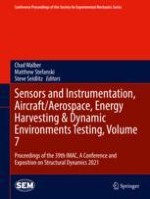2022 | Book
Sensors and Instrumentation, Aircraft/Aerospace, Energy Harvesting & Dynamic Environments Testing, Volume 7
Proceedings of the 39th IMAC, A Conference and Exposition on Structural Dynamics 2021
Editors: Chad Walber, Matthew Stefanski, Steve Seidlitz
Publisher: Springer International Publishing
Book Series : Conference Proceedings of the Society for Experimental Mechanics Series
